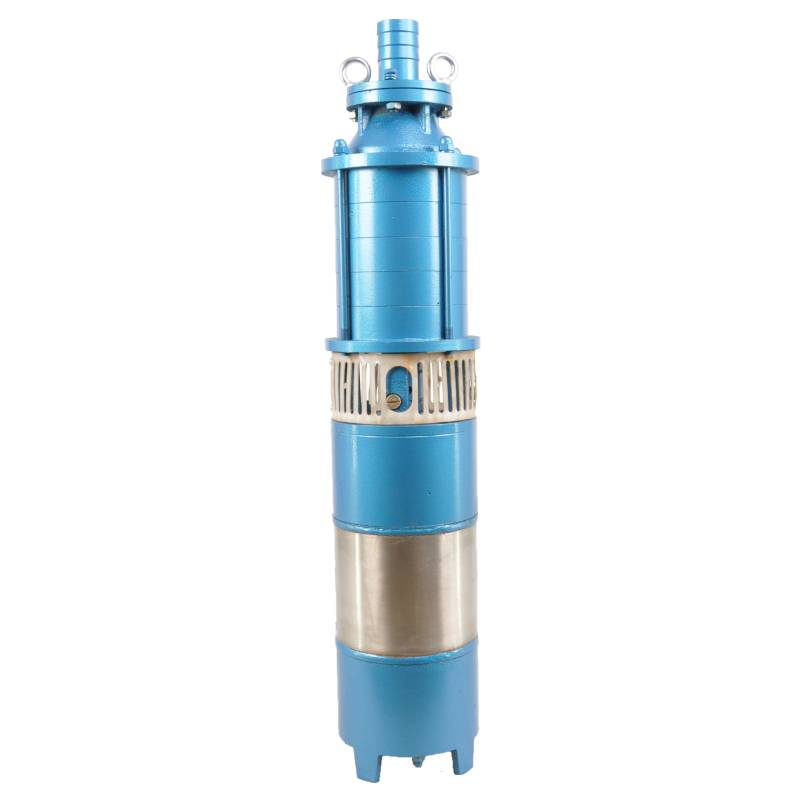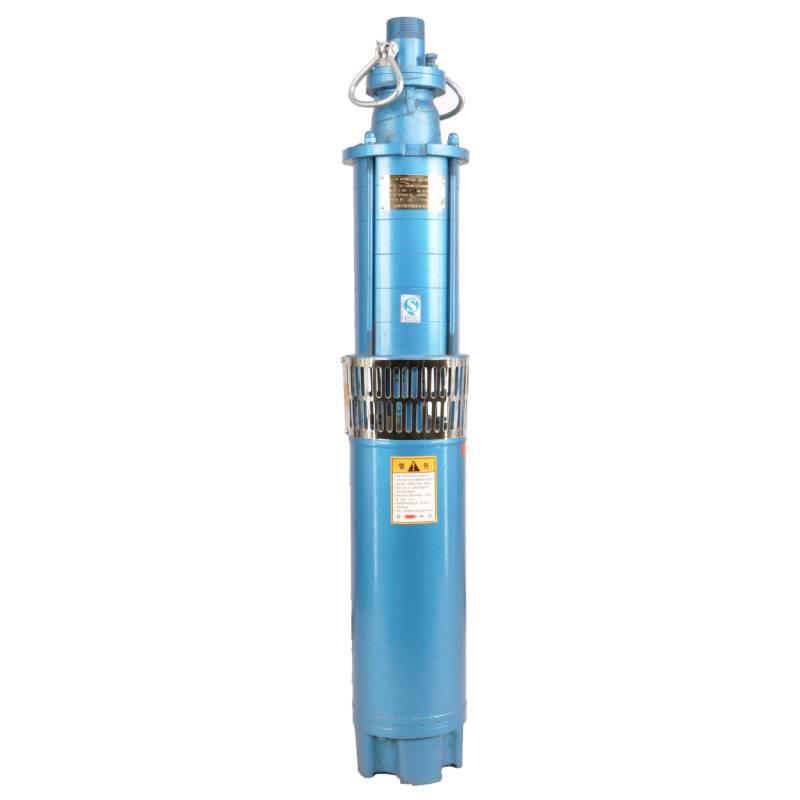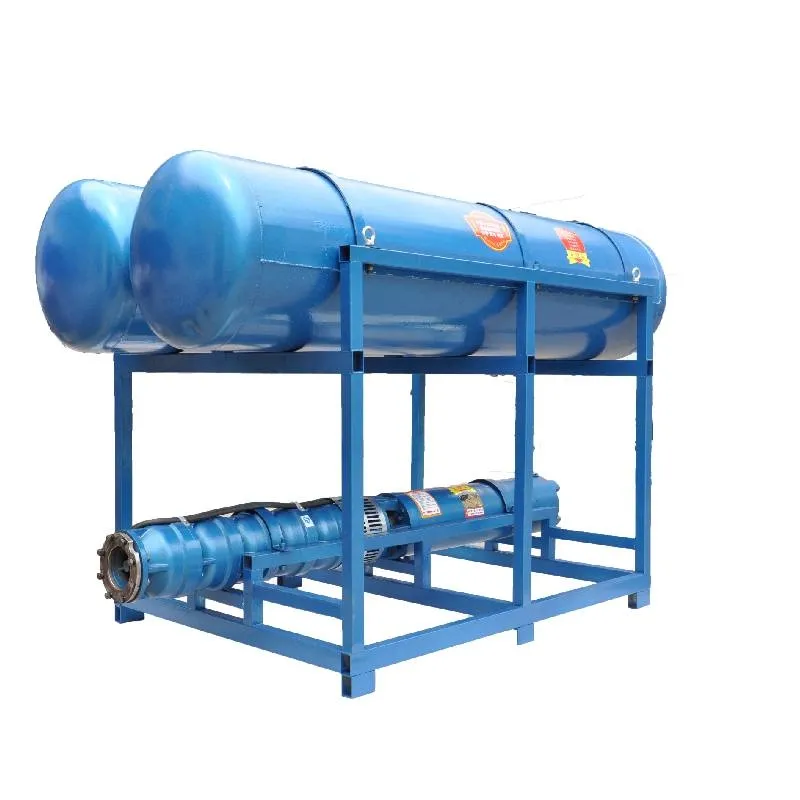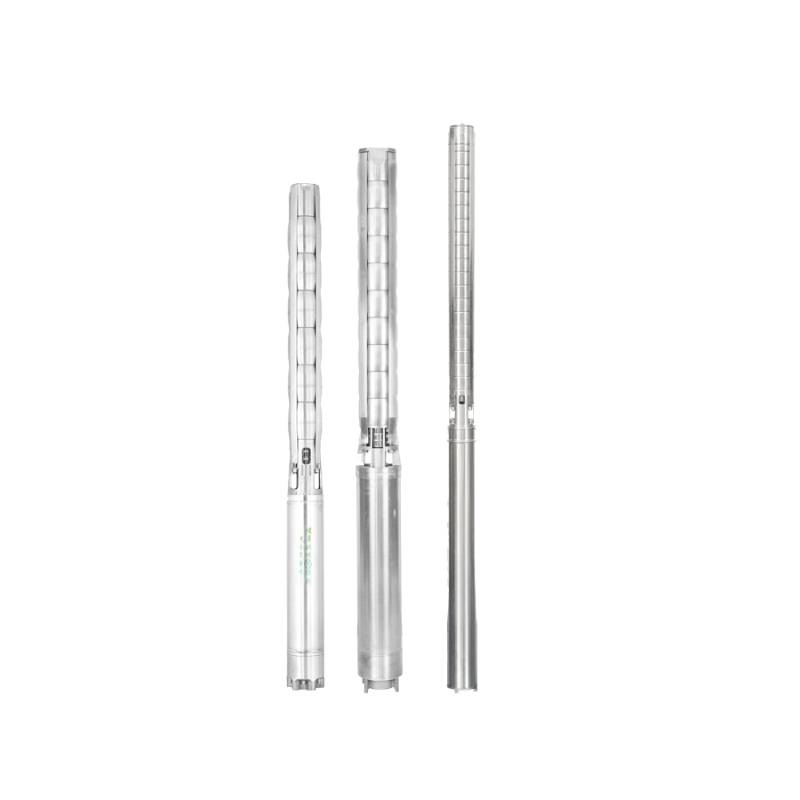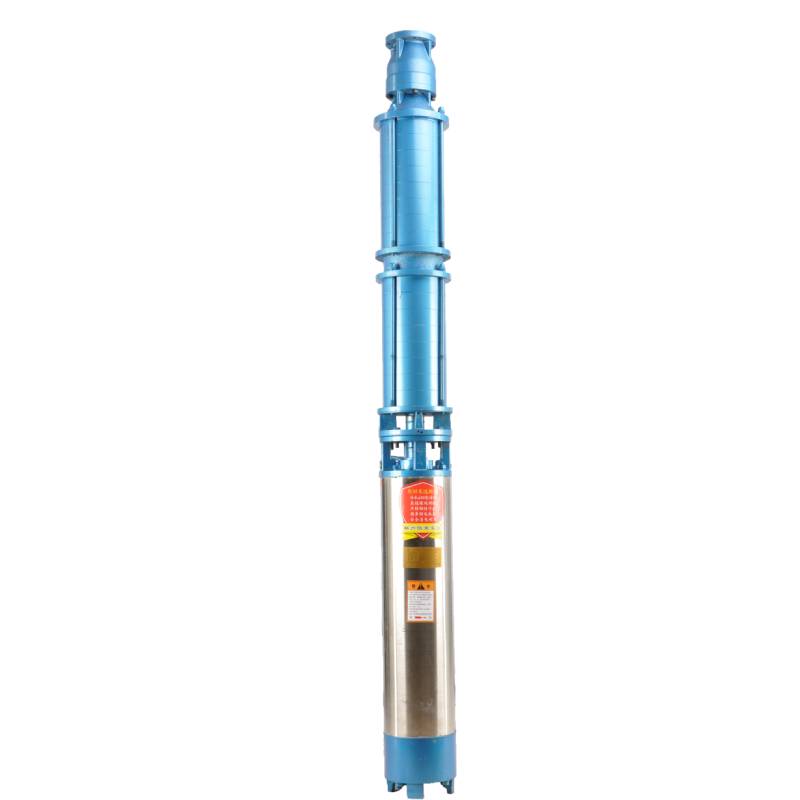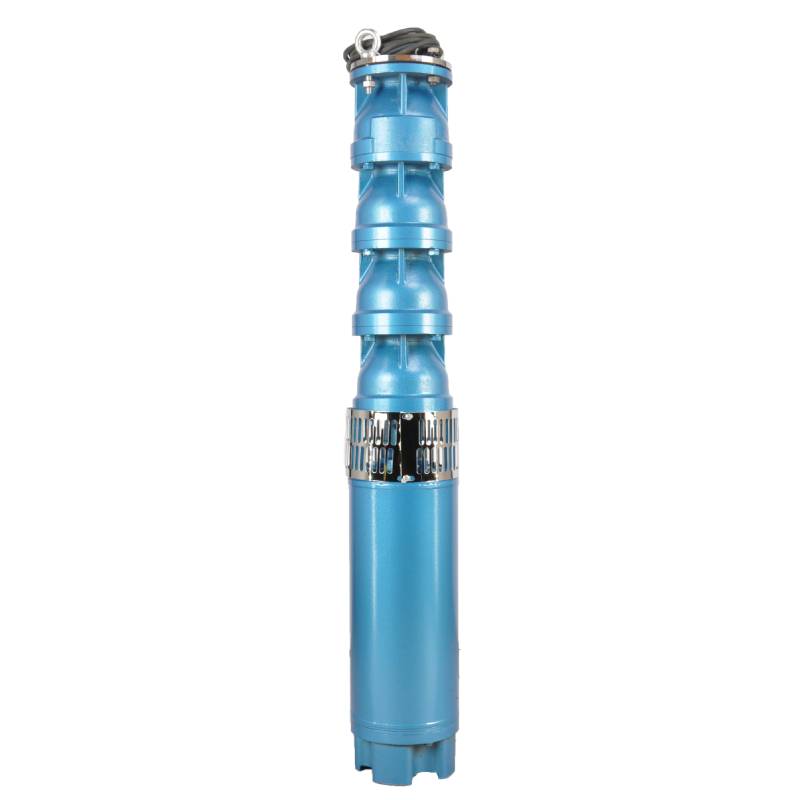Series electricorum submersibilis QS est novum genus irrigationis et incilia machinae. Haec series soleatus verticales sunt, adhibito consilio radiali positivo et negativo duce vane, parvum volumen, leve pondus, altum elevatum, facilem institutionem et motum, facilem sustentationem et operationem.
Fluunt range 5-50m3/h, leva 5-800m.
The product is equipped with three-phase AC 380V (tolerance is ± 5%), 50 Hz (tolerance is ± 1%) power supply. Water quality requirements are:
(1) water temperature shall not be higher than 20 °C;
(2) Immutationes solidae contentae non erunt majores quam 0.01%;
(3) PH valor 6.5-8.5;
(4) hydrogenii sulfidelis contentum majus quam 1.5 mg / L non habebit;
(5) Ion contentum chloridum non maius 400 mg / L. Motor est structurae humidae clausa vel aqua repleta.
Ante usum, cavitas interioris motoris submersibilis aqua munda replenda est, et aquae iniectio et aer fulmina constringentur, alioquin non adhibebitur. Sentina submersibilis totaliter in aqua ad operandum immergi debet, insertio profunditatis 70 metrorum non excedat, et distantia inter fundum submersibilem et fundum putei non minus quam 3 metrorum erit. Aquae putei occurrent aquae attractio et continuae operationis exigentias sentinae submersibilis, et aqua output sentinae submersibilis ad 0.7-1.2 temporibus fluxus aestimatus continebitur. Puteus verticalis esse debet, et sentinam submersibilem non horizontaliter vel inclinari potest, sed perpendiculariter tantum. Sentinam submersibilem aequare funibus oportet et cum exterioribus oneris machinis tutelam uti postulabat instructum. Sentina submersibilis a probatione sine aquae onere stricte prohibetur.
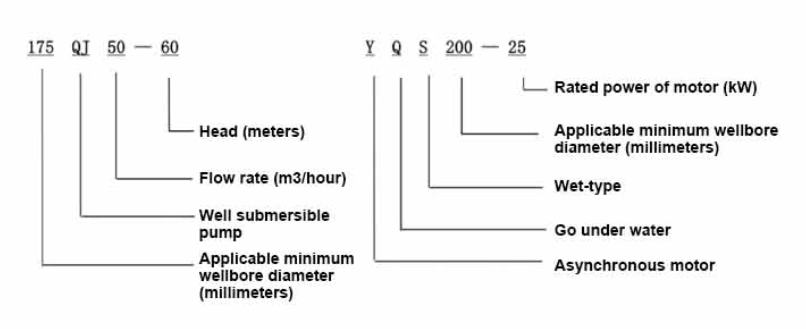
| 200 QS submersible sentinam perficiendi mensam Non-vexillum nativus series |
||||||||
| exemplar | exemplar | |||||||
| QS5-70-2.2KW | QS10-52-4KW | |||||||
| QS5-90-3KW | QS10-70-5.5KW | |||||||
| QS5-108-4KW | QS10-90-7.5KW | |||||||
| QS5-126-5.5KW | QS10-108-7.5KW | |||||||
| QS5-144-5.5KW | QS20-40-4KW | |||||||
| QS5-166-7.5KW | QS20-54-5.5KW | |||||||
| QS5-180-7.5KW | QS20-65-7.5KW | |||||||
| QS10-36-2.2KW | QS20-81-7.5KW | |||||||
| QS10-54-3KW | QS32-13-2.2KW | |||||||
| QS10-70-4KW | QS32-26-4KW | |||||||
| QS10-90-5.5KW | QS32-52-7.5KW | |||||||
| QS10-108-5.5KW | QS40-39-7.5KW | |||||||
| QS10-126-7.5KW | QS40-13-4KW | |||||||
| QS10-140-7.5KW | QS40-26-5.5KW | |||||||
| QS15-38-3KW | QS50-13-4KW | |||||||
| QS15-54-4KW | QS50-26-5.5KW | |||||||
| QS15-65-5.5KW | QS50-39-7.5KW | |||||||
| QS15-81-5.5KW | QS63-12-4KW | |||||||
| QS15-100-7.5KW | QS63-24-7.5KW | |||||||
| QS20-30-3KW | QS80-11-4KW | |||||||
| QS20-45-4KW | QS80-22-7.5KW | |||||||
| QS20-60-5.5KW | QS10-88-7.5KW | |||||||
| QS20-75-7.5KW | QS10-105-7.5KW | |||||||
| QS20-81-7.5KW | QS40-52-11KW | |||||||
| QS10-198-15KW | QS50-60-11KW | |||||||
| QS10-160-9.2KW | QS65-30-9.2KW | |||||||
| QS15-180-15KW | QS80-28-9.2KW | |||||||
| QS10-180-11KW | QS125-15-7.5KW | |||||||
I, sentinam submersibilem bene sentinam aquam mundam, aquam novam lavare prohibe, sedimen et aquam turbidam flare;
2, puteus aquae sentinae voltage gradus 380/50HZ, usus aliorum motorum submersibilium voltagenarum ut nativus sit necesse est. Funes downhole uti debent IMPERVIUS cable, instructi instrumentis incipientibus, ut distributio capsa, non promptum munus commune habere debet tutelae motricis comprehensivae, ut brevis circuitus oneris tutelae, Phase tutelae, tutelae minoris tutelae, munitio tutelae, tutelae terens, in. casus abnormis condicionum, machinatio tutelae debet esse opportuna actio itineris.
III, sentinam in processu institutionis et usu certo fundari debet. Prohibitum in manibus et pedibus infectum switch dis-traho. Ante institutionem et sentinam conservandam, potestas abscindenda est. Instructum in loco ubi sentinam adhibetur, signanter notari debet "ne electricum concussum". Priusquam ad puteum vel institutionem descendat, cavitas motoria replenda aqua destillata vel aqua munda non mordax est, ac fulmen aqua / exhaurire debet.
4, cum operatione sentinae loci colloquium, aqua in sentinam cameram infundi debet ut iuvantis ferentem praelinm. Tempus initium instans unum secundum non excedens, inspicias an directio sit eadem ac gubernatio instructio. Cum recta sentina est, attende ad salutem, ne evertat iniuriam.
V, stricte secundum praescripta sentinae tollunt, profluunt usus, ne gravis fluat vel alte elidens vim levare, impulsum ferens et aliae partes induendi, motor oneris combusti 6, post puteum sentinam descendunt; Mensuratio motoris ad terram resistentiae velitae non minus quam 100M esse debet, post initium intentionis et currentis observandi, sisto motore sinuoso insito, sive secundum exigentias; sentinam repono locationis temperaturae si minus quam punctum congelatur, aquae motoris cavitatis aridae esse debet, ne aquae motoris cavitatis glacies per humilitatem damni causata sit.
The pump part is mainly composed of pump shaft, impeller, guide housing, rubber bearing, check valve body (optional) and other components. The motor part mainly includes base, pressure regulating diaphragm, thrust bearing, thrust plate, lower guide bearing seat, stator, rotor, upper guide bearing seat, sand discharging ring, water inlet section, lead cable and other components. The main characteristics of this product are that the motor is a water-immersed three-phase asynchronous motor, and the motor cavity is filled with water to cool the motor and lubricate the bearing. The pressure regulating film at the bottom is used to adjust the pressure difference of the water body in the cavity caused by the temperature rise of the motor. In order to prevent the sand from entering the motor, the upper end of the motor shaft extension is equipped with two oil seals and installed a sand discharging ring, forming a sand prevention structure. At the same time, in order to prevent the pump shaft from jumping when starting, the pump shaft is connected with the motor shaft by a coupling, and the thrust bearing is installed under the motor. The lubrication of the whole product is water lubrication, and the motor stator winding is made of high quality submersible motor winding wire with high insulation performance. In addition, the pump is designed by computer CAD, with simple structure and excellent technical performance.

(I) Praeparatio ante institutionem:
1. Perspice an sentinam submersibilem usui conditionibus occurrat et ambitum in manuali definitum.
2. Utens obiectu gravi cum diametro aequali maximo diametro exterioris sentinae submersibilis, metire an inneldiametri putoris sentinam submersibilem aptare possit, et metire an puteus profundus ad institutionem requisita occurrat.
3. Reprehendo utrum puteus mundus sit, et si puteus aqua turbidus est. Numquam uti sentinam electricam submersibilem ad lavandum putorem sentinam lutum et aquam arenam ad vitandum praematurum damnum ad sentinam electricam submersibilem.
4. Reprehendo an positio fibulae institutionis welhead sit conveniens et an qualitatem totius unitatis sustinere possit
5. Reprehendo si partes sentinae submersibiles sint perfectae et rite institutae secundum schematis conventus in manu-Removeo velum colum et gyrari queat ad videndum an mollius circumagatur.
6. Aquam cochleae et cavum mobilem reple, non mordax aqua (ex corrosivis (vide ut eam sursum), tum obstringas aqualram. Post 12 horas aquae injectiones, insulatio motoris resistentia non minus quam 150M Q mensurata est cum 500V tabula quatiens.
7. Cable joint, cut off a 120mm rubber sleeve from one end of the outgoing cable and the matching cable with an electrician's knifethen stagger the length of the three core wires in a stepped shape, peel off a 20mm copper core, scrape of the oxide layer on theoutside of the copper wire with a knife or sand cloth, and insert the two connected wire ends in palirs.After tying the layer tightly with fine copper wire, solder it thoroughly and firmly, and sand of any. burrs on the surface. Then, forthe three joints, use polyvester insulation tape to wrap them in a semi stacked manner for three lavers. Wrap the two ends of thewrapping layer tightywith nyion thread,and then use a semi stacked method to wrap the tape for three layers. Wrap the outellayer with high-pressure insulation tape for three layers. Finally, fold the threestrands together and repeatedly wrap them for fivelayers with high-pressure tape. Each layer must be tightly tied, and the interlayer joints must be tight and fimm to prevent water frompenetrating and damaging the insulation, After wrapping, soak in water at room temperature of 20 ’c for 12 hours, and measurethe insulation resistance with a shaking table, which should not be less than 100M Ω
Adnexa funis processus schematis wiring talis est: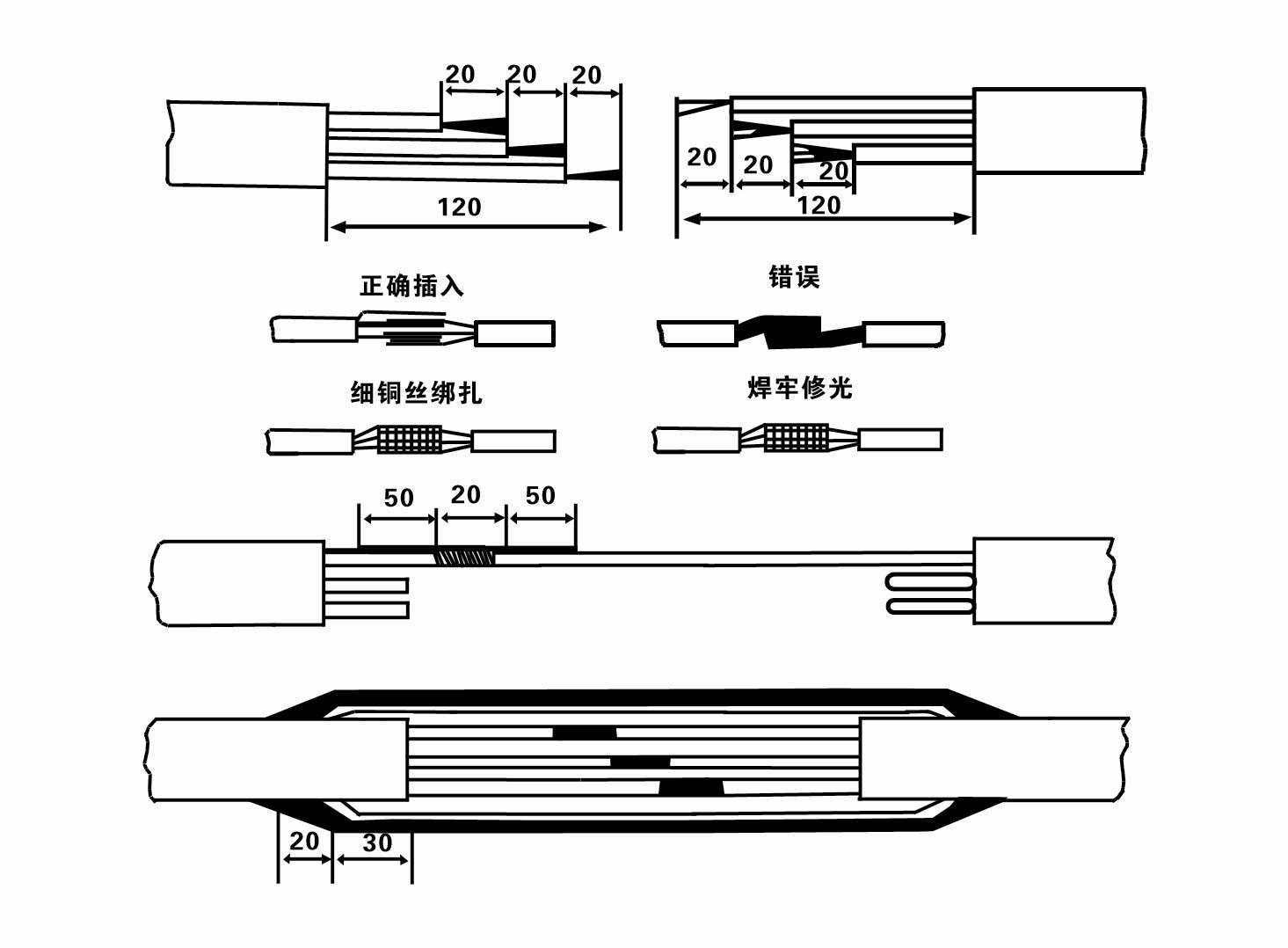
8. Multimetro utere ad reprimendam num tria-phasma fila connexa sint et an resistentia DC proxime libratum sit.
9. Perscriptio num ambitus et transformantis capacitas cumulatur, et tunc coniunge cum onere transitum tutelae vel apparatum incipiens. Vide Tabulam 2 ad exempla specifica, et mitte situlam aquae in sentinam aquae ex aqua sentinae exitum ad praestringendum iuvantis gestus in sentinam, et pone sentinam submersibilem electricam erectam et constantem.Start (non plus quam unum secundum) et vide utrum directio gubernii sit cum signo gubernaculo consonans. Sin minus, aliquos duos connexiones trium-phase cables permuto. Deinde colum inaugurare et ad puteum descendere parant. Si in peculiaribus occasionibus adhibeantur (sicut fossae, fossae, flumina, stagna, stagna, etc.), sentinam electricam certo fundari debent.
(2) Installation instrumentorum et instrumentorum;
1. Unum par catenarum levandi plus duobus talentis.
2. Tripode cum perpendiculo non minus quam quattuor metra.
3. Duo funes suspensi (funes filum) qui pondus plus quam unum ton ferre possunt (pondere aquae soleatus completae).
4. duo paria fibulatorum inaugurare (facile).
5. Clavis, malleis, verticillis, instrumentis electricis et instrumentis, etc.
(III) Electric sentinam institutionem:
1. Tabulae institutionis sentinae submersibilis electrici in Figura ostenditur 2. Specificae institutiones dimensiones in Tabula 3 monstrantur "Index institutionis Dimensiones Submersible Electric Pump".
2. Solatus electrici submersibiles cum capite minore quam 30 metra directe levari possunt in puteum caligarum et funiculos filum vel alias funiculos cannabinos, qui plenum pondus totius machinae, fistulae aquae et aquae in tibiis ferre possunt.
3. Pumps cum capite plusquam 30 metrorum utimur fistulis ferreis, et series institutionis haec est:
① Fibulae utere ad fibulae partem superiorem sentinam aquae (motricis et aquae sentinae hoc tempore coniunctae sunt), eam cum cathena pensili tolle, et lente eam in puteum ligabis, donec Fibulae in putei caput auferas et removeas. catena pendula.
② Alterum par fibularum utere ad fistulam fibulae, eam leva cum cathena pendula 15 cm a LABIUM, et lente deprime. Inter fistulam LABIUM et sentinam flangePut Flexilis caudex in loco, et obstringere tibiam et sentinam aequabiliter cum valvis, nucibus et lavatoribus veris.
③ Sentinam submersibilem leviter tolle, fibulam in superiore fine aquae sentinae tolle, funem ligabis ad fistulam aquae cum taenia plastica firmiter, et lente ligabis eam donec Fibulae ad putei caput ponatur.
Eadem methodo omnes aquae fistulas in puteum alligant.
⑤Post funem plumbeum ad imperium transitum coniungitur, cum copia trium phase iungitur.
(4.) Notae in installation:
1. Si vallum phaenomenon in flantibus processum inveniatur, vertere vel fistulam aquam trahere, ut punctum vallum superetur. Si variae mensurae adhuc non operantur, quaeso Noli sentinam cogere ad vitandum damnum in sentinam electricam et puteum submersibilem.
2. In institutione, codex iuvantis ad cuiusque fistulae LABIUM collocari debet et aequaliter coarctari.
3. Cum aqua sentina in puteum demissa, in media fistula putei poni debet, ne sentinam contra murum putei diu curreret, sentinam pulsum et motorem verrere et comburere. .
4. Determinare profunditatem aquae sentinae ad imum putei iuxta arenam fluentem et condiciones putei limum. Sentinam in luto non sepelias. Distantia aquae sentinae ad fundum putei fere non minus quam 3 metra (vide figura 2).
5. Aquae viscus profunditas aquae sentinae non minus esse debet quam 1-1.5 metra a gradu aquae dynamicae ad nodi aquae diverticulum (vide Figure 2). Alioquin aquae sentinae gestus facile laedantur.
6. Aquae levare sentinam nimis humilis esse non potest. Alioquin valvae portae aquae putei fistulae inaugurari debet ut fluere sentinam fluere apud punctum aestimatum fluere prohibeat ne motor oneretur et exuratur propter magnas rates fluxus.
7. Cum aqua currit sentina, aqua output continuum et par esse debet, currens sit stabilis (sub condiciones operationis aestimatae, plerumque non plus quam 10% currentis aestimatae), nec vibratio nec strepitus esse debet. Si qua deprauatio est, machina cessari debet causam cognoscendi et removendi.
8. Cum inaugurari, attende ad occasum filum fundationis motoris (vide Figure 2). Fistula cum aqua est ferrea tibia, a puteo fibulato duc; cum fistula aquatica fistula plastica est, eam a fundamento sentinae electrici notam duc.
The use of underwater pumps need to be carried out in strict accordance with the following steps: First of all, after the installation of the underwater pump, it is necessary to recheck the insulation resistance and the three-phase continuity of the switch, and check whether there are errors in the connection of the instrument and the start equipment. If there is no problem, you can start to test the machine. After the start, observe whether the indication readings of each instrument are correct. If the rated voltage and current specified on the nameplate are exceeded, please observe whether the pump has any noise or vibration. If everything is normal, it can be put into operation. The second step, after the pump runs for four hours for the first time, it should be closed and the thermal insulation resistance of the motor should be tested quickly. Its value should not be less than 0.5 megaohm. The third step, after the pump stops, it should be restarted after five minutes to prevent the water column in the pipeline from completely reversing, resulting in the motor burning due to excessive current. The fourth step, after the pump is put into normal operation, in order to prolong its service life, it is necessary to check the power supply voltage, operating current and insulation resistance regularly to see if they are normal. If the following conditions are found, the machine should be shut down immediately to troubleshoot:
1 the current exceeds 20% under the rated working conditions.
2 the dynamic water level drops to the inlet section, causing intermittent drainage.
3 the underwater pump vibrates violently or makes a lot of noise.
4 the supply voltage is lower than 340 volts.
5 a fuse burned. 6 water pipe damage.
7 the motor to the ground thermal insulation resistance is less than 0.5 megaohms.
The fifth step, the removal of the unit:
1 untie the cable tether, remove the pipe part, and remove the line protection plate.
2 screw down the water bolt and discharge all the water in the motor chamber.
3 remove the filter and loosen the fixing screw on the coupling fixed motor shaft.
4 screw down the bolt connecting the water inlet section and the motor, separate the pump and the motor (pay attention to make the unit level to prevent the bending of the pump shaft when separating)
5 the removal sequence of the pump is: (see Figure 1) water inlet section, impeller, shunt shell, impeller, check valve body. When removing the impeller, use special tools to loosen the cone sleeve fixed the impeller. In the process of removal, avoid bending the pump shaft and damage the various parts.
6 the removal process of the motor is: (see Figure 1) put the motor on the platform, and in order from the bottom of the motor bolt nuts, base, shaft head lock nut, thrust plate, key and lower guide bearing seat (iron rod bolt) on the connecting parts, and then take out the stator (careful not to damage the wire packet), and finally remove the connecting part and the upper guide bearing seat. Unit assembly: before assembly, rust and dirt on each component should be cleaned and sealant should be applied to each mating surface and fastener, and then the assembly should be carried out in reverse order of disassembly (the motor shaft moves about 1 mm after assembly), the coupling should be flexible after assembly, and then the filter should be put on for testing. Step six, after each use of the underwater electric pump operation for one year, or less than one year but immersed for two years, the disassembly and inspection should be carried out in accordance with the provisions of Article 5 to replace the worn parts.
I, aquam in cavo motorio extingue (praesertim hieme ne motor a frigore) et funem bene ligaveris.
2, store in an indoor room without corrosive substances and gases, with a temperature below 40 °C.
III, diu terminus usus observandum ne rubigo soleatus submersible.
- Impeller
- hastile sleeve
- Flexilis scapus sleeve
-
signantes anulum
I Aquam profunda bene attractio
II High-surgere aquarum copia
03 mons aquae copia
04 aqua turris
05 Irrigatio agriculturae
VI hortus irrigationis
07 attractio aquae fluminis
08 aqua domestica


